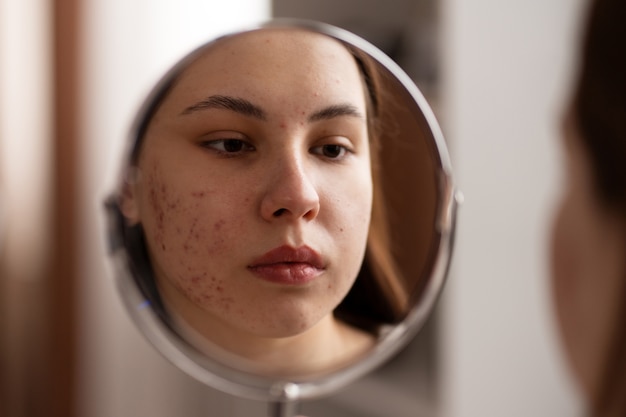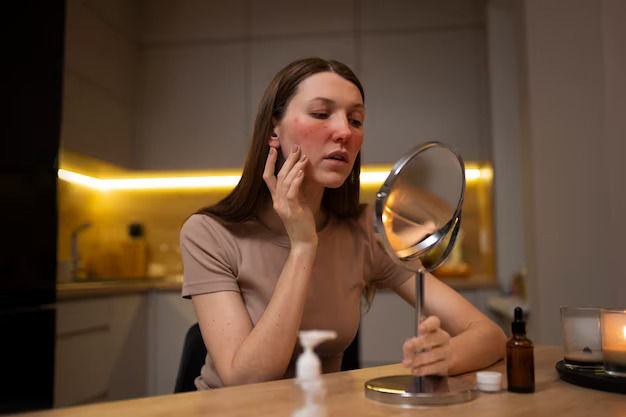It’s widely held that makeup and acne have a complex relationship. Many of us slather on concealers or foundations to hide those pesky spots, yet we often hear warnings that these products might be causing our skin troubles. But is there any truth to this claim? Does makeup cause acne, or is it just a skincare myth?
This article with Dr Justin Boey, Medical Director of Sozo Aesthetic Clinic, will delve deep into this topic. Exploring the potential connection between cosmetics and breakouts and providing essential advice on maintaining healthy, acne-free skin even while enjoying your favourite makeup products.
Contents
What is Acne?
Acne is a common skin condition characterised by the appearance of spots on the skin. These spots can vary in nature and severity, ranging from blackheads and whiteheads, which are generally mild, to more serious forms like papules, pustules, nodules, and cysts. The root cause of acne is the blockage of hair follicles by sebum, a naturally occurring oil in the skin, and dead skin cells. Certain factors can exacerbate this issue, including hormonal changes (common in teenagers and pregnant women), certain medications, dietary choices, and stress. Importantly, while it’s most commonly associated with adolescence, acne can affect individuals at any stage of life.
Can Makeup Cause Acne?
The question, ‘Can makeup cause acne?‘ is a complex one to answer. It’s more accurate to say makeup can contribute to the development of acne if not chosen and used correctly. Certain types of makeup contain ingredients that can block pores, leading to the build-up of sebum and dead skin cells that we know can result in acne. This condition is so common that it even has its name: acne cosmetics.
Common culprits in makeup products are oils and silicones, often used for their smoothing, blurring, and water-resistant properties. While these ingredients make cosmetics perform better and last longer, they can also lead to clogged pores, particularly if the makeup is not thoroughly removed at the end of the day.
However, it’s essential to note that not all makeup causes acne. Non-comedogenic products, specifically formulated to not block pores, can be safer for acne-prone skin. Additionally, makeup can act as a protective barrier against environmental factors like pollution and sunlight, further irritating acne-prone skin.
In conclusion, it’s not the makeup that generally leads to acne, but rather the misuse of makeup – such as using products with pore-clogging ingredients or not properly removing makeup – that can contribute to causing breakouts themselves. With careful product selection and a proper skincare regimen, makeup can still be enjoyed, even by those with acne-prone skin.
What are Comedogenic Products?
Comedogenic products tend to block pores, potentially leading to the formation of comedones—blackheads and whiteheads—and, ultimately, acne. The term “comedogenic” derives from “comedo,” the least severe form of acne, which arises when a blend of excess sebum and dead skin cells gets trapped in a pore and forms a plug.
Several ingredients found in cosmetics can be comedogenic. These include but are not limited to certain oils like coconut oil, palm oil, and wheat germ oil, which are high on the comedogenic scale; isopropyl myristate and isopropyl palmitate, which give products a pleasing smooth and silky feel; alcohols such as cetearyl and stearyl alcohol, which act as emollients and emulsion stabilisers; and thickening agents like cetyl acetate and acetylated lanolin alcohol, which can lead to acne if not thoroughly removed. A quick look at the ingredient list of your makeup products can help determine whether they are likely to clog pores and cause acne. The rule of thumb is the higher these ingredients appear on the list, the higher their concentration in the product.
However, not all oils and alcohols are harmful. Some, such as sunflower oil and cetyl alcohol, are considered non-comedogenic. Additionally, certain skincare ingredients, like salicylic acid and niacinamide, can help combat the effects of pore-clogging ingredients and may be beneficial additions to your skincare routine if you are prone to acne.
What is Non-Comedogenic Makeup?

Non-comedogenic makeup is designed specifically with the health of your skin in mind. ‘non-comedogenic’ refers to products that do not block pores, reducing the chances of comedones (blackheads and whiteheads) and acne development. These products contain less likely ingredients to cause acne, making them a safe choice for those with acne-prone skin.
Non-comedogenic makeup can be beneficial for acne-prone skin, as it is less likely to contribute to the accumulation of excess oil, dead skin cells, and other substances within your pores, a common cause of acne. This means that even after applying makeup, your skin can continue to breathe and maintain its natural functions without being weighed down by potentially pore-clogging substances.
Several ingredients to look for in non-comedogenic products are typically included due to their skin-friendly properties. These include:
Zinc Oxide: An excellent sunscreen and non-irritating anti-inflammatory agent.
Silica: Helps absorb oils and gives a matte finish.
Titanium Dioxide: Another effective sunscreen and gentle colouring agent on the skin.
Kaolin Clay: A natural clay that absorbs excess oil without stripping the skin.
Dimethicone: A silicone that provides a smooth application and doesn’t clog pores.
Salicylic Acid: Helps to exfoliate and prevent clogged pores.
Niacinamide: A form of vitamin B3 that helps improve skin texture and tone.
Common Myths
Many myths surround the relationship between makeup and acne, leading to confusion about whether makeup can cause or alleviate acne. Here are a few common misconceptions:
#1 Makeup Always Causes Acne
One myth often heard is that makeup always causes acne. While it’s true that certain products can exacerbate acne, makeup alone is not typically the sole culprit. Acne is a complex condition influenced by a multitude of factors which often interact in complex ways. Some of the common factors that contribute to acne include:
Hormonal changes: Hormones play a significant role in acne development. Hormonal fluctuations, especially during puberty, pregnancy, and menstrual cycles, can stimulate sebum production, potentially leading to acne.
Genetics: You may also develop the condition if your parents have acne.
Stress: Elevated stress levels can trigger hormonal changes and inflammation, contributing to acne breakouts.
Poor diet: Consuming a diet high in refined sugars and unhealthy fats can trigger inflammation and acne.
Poor hygiene: Not washing your face regularly or adequately can lead to the build-up of oil and dead skin cells, which can clog pores and cause acne.
Medications: Certain medications, including certain contraceptives and corticosteroids, can cause acne.
#2 All Makeup Products Are the Same
A prevalent myth is that all makeup products are identical in formulation and impact on the skin. However, the reality is far from this. The formulation and constituent ingredients can vary significantly across different makeup products, even within the same category. For instance, two seemingly similar foundations may have distinctly different ingredient lists and, therefore, different effects on the skin.
This variation in formulation underscores the importance of carefully choosing makeup products, particularly for individuals with acne-prone skin. Opting for non-comedogenic products is crucial to avoid clogging pores and reduce the potential for acne development. These products contain skin-friendly ingredients that allow your skin to breathe and maintain its natural functions, even under makeup.
Moreover, choosing makeup that has been dermatologist-tested provides an additional layer of assurance. Dermatologist-tested means that skin experts have reviewed and approved the product, ensuring its safety and efficacy. Such products are typically less likely to either irritate skin or worsen existing skin conditions, making them a preferred choice for those with sensitive or acne-prone skin.
In summary, the makeup you choose can play a significant role in managing acne. It’s essential to read labels, recognize your skin’s needs, and opt for non-comedogenic and dermatologist-tested products. Not all makeup products are created equal — the right ones can allow you to express yourself creatively with makeup without compromising skin health.
#3 Makeup Can Make Acne Worse
This third myth suggests that makeup can exacerbate existing acne, which is inaccurate. While certain types of makeup and poor application habits can potentially worsen acne conditions, it’s possible to use makeup without aggravating existing acne. The key lies in choosing the right products and using them correctly.
If you have acne-prone skin, here are a few guidelines for selecting suitable makeup products:
Choose Non-Comedogenic Products: As mentioned earlier, non-comedogenic products are designed to avoid clogging pores, reducing the chances of acne development. Always check the label for this key term.
Look for Oil-Free Products: Oil-free makeup products are typically lighter and less likely to cause pore blockages. They’re a good option if you tend to have oily skin.
Opt for Mineral-Based Products: Mineral-based makeup products can be less irritating to the skin and provide good coverage without being heavy. They can also help to absorb excess oil on the skin’s surface.
Avoid Fragrance and Irritants: Fragrance in makeup products can irritate the skin, leading to inflammation that could worsen acne. Similarly, avoid products containing irritants like alcohol.
Look for Acne-Fighting Ingredients: Some makeup products contain ingredients like salicylic acid or tea tree oil, which can help fight acne.
Choose makeup that’s right for your skin type: You should look for not only makeup that suits acne-prone skin but also makeup that is right for your specific skin type, whether dry, oily, or combination.
Lastly, always cleanse your face thoroughly before applying makeup and remove it fully at the end of the day. This helps to keep your pores free from makeup residue and reduces the chance of acne development.
Makeup Tips for Acne-Prone Skin
Here are some practical tips for those with acne-prone skin who wish to use makeup safely:
Cleanse Before Application: Always start with a clean canvas. Wash your face with a gentle cleanser before applying makeup to ensure you’re not trapping any dirt or oil beneath the makeup.
Use Brushes Instead of Fingers: Applying makeup with clean brushes or sponges instead of your fingers can reduce the transfer of oil and bacteria to your face. Remember to clean your makeup tools regularly!
Spot Concealing: Opt for spot concealing instead of covering your entire face with a heavy foundation. This means only applying concealer to blemishes and under-eye circles, where coverage is needed most.
Avoid Touch-ups: Avoid touching up your makeup throughout the day, which can push the makeup deeper into your pores, leading to blockages. If oiliness is a concern, use oil blotting sheets to keep your skin looking fresh.
Remove Makeup Before Bed: Never go to bed with your makeup on! Always thoroughly remove your makeup at the end of the day to prevent it from clogging your pores overnight.
Makeup for Different Skin Types

Understanding your skin type is vital when selecting makeup, especially if you’re prone to acne. Here, we’ll look at how to choose products for oily, dry, and combination skin types:
Oily Skin: If your skin tends to be shiny and greasy, you will likely have oily skin. Opt for oil-free and non-comedogenic products, which prevent clogged pores and reduce oil build-up. Products labelled ‘mattifying’ or ‘shine control’ could also help combat the greasiness. In your makeup choices, mineral-based foundations and powders can absorb excess oil and reduce shine.
Dry Skin: Dry skin often feels tight or flaky. For this skin type, look for makeup that has a hydrating or moisturising formula. Cream-based products or those labelled ‘hydrating’ can help add moisture and prevent makeup from settling into dry patches. Avoid makeup products with alcohol, as it can dry out the skin even further.
Combination Skin: Combination skin is a mix of oily and dry areas. The T-zone (forehead, nose, and chin) tends to be oily, while the cheeks are dry. For this skin type, you might need to mix and match products. Use mattifying products on oily areas and hydrating ones on dry areas.
Application Techniques
Adopting proper makeup application techniques is as crucial as selecting the right makeup products for your skin. Here are some key strategies that can help minimise pore clogging and prevent breakouts:
Use of Makeup Brushes and Sponges: Makeup brushes and sponges are preferred over fingers for applying makeup as they can give a more even, blended finish and reduce the risk of transferring oil and bacteria that could clog pores. Ensure your brushes and sponges are clean before you use them, and aim to wash them at least once a week with a mild shampoo or brush cleaner to keep them bacteria-free.
Apply makeup in gentle, sweeping motions when using a brush or sponge. Avoid dragging or pressing too hard, irritating the skin and pushing makeup into pores. Moreover, using a separate brush for powder-based products (like bronzer or blush) and another for liquid or cream products (such as foundation or concealer) to clean your makeup brushes can also help reduce product build-up on the tools.
Light Layering: Instead of applying a thick layer of makeup all at once, aim for light, multiple layers. Start with a small amount of product and gradually build it up if more coverage is needed. This approach reduces the excess makeup that could enter and clog your pores.
Avoid T-zone: The T-zone (forehead, nose, and chin) is usually the oiliest part of the face and thus the most prone to acne. Try to use less makeup in these areas to reduce the chances of pore clogging skin irritation.
Thorough Makeup Removal: A critical step in preventing acne is to remove your makeup at the end of the day. Leaving makeup on overnight can lead to clogged pores, oily skin, and potential breakouts. Start with a makeup remover or micellar water to break down makeup, followed by a gentle cleanser to remove any remaining residue. Use a dedicated makeup remover to gently and effectively remove long-wearing products for areas like the eyes and lips.
Remember, every step you take towards treating your acne-prone skin with care can make a huge difference in the health and appearance of your skin. Make these techniques a part of your daily routine to help manage acne and enjoy the benefits of makeup without worrying about its impact on your skin.
Skincare Routine
Maintaining a consistent skincare routine is crucial, especially for those who regularly wear makeup. This routine should ideally involve the three core steps: cleansing, toning, and moisturising, twice a day – in the morning before applying makeup and in the evening after removing it.
Morning Routine
To start your day, it’s important to use a gentle cleanser to remove any oil and impurities that may have accumulated on your skin overnight. After cleansing, use a toner to balance your skin’s pH level and prepare it for the next step – moisturizing. You should use a moisturizer that includes SPF to protect your more sensitive skin further from the harmful sun rays. Alternatively, you can use a separate sunscreen after applying your regular moisturizer. If you have acne-prone skin, using a non-comedogenic moisturiser is important to avoid clogging your pores.
Evening Routine
Your evening routine should begin with the thorough removal of makeup. You can use micellar water or an oil-based makeup remover to dissolve stubborn makeup, followed by a gentle cleanser to remove all makeup residue. Use a toner to remove any last trace of makeup or cleanser, and then apply a moisturiser to keep your skin hydrated overnight. If you have acne-prone skin, consider using an acne treatment product at this stage.
Acne treatments can often dry out your skin, disrupting your makeup application, but there are ways to combat this. Firstly, ensure you use a product suitable for your skin type and acne severity. This could be an over-the-counter product containing ingredients like salicylic acid or benzoyl peroxide or a prescription treatment if your acne is severe or persistent.
To prevent skin dryness:
Apply the acne treatment only on the affected areas and follow up with a hydrating, non-comedogenic moisturiser.
Wait for the treatment to fully absorb before applying moisturiser, and let your skin rest for a few minutes before moving on to makeup application.
Remember to hydrate your skin throughout the day to combat any dryness caused by acne treatments.
Seek Professional Guidance
If you’re struggling with persistent or severe acne that’s proving difficult to manage, don’t hesitate to seek professional help. A dermatologist can provide personalised treatments and advice tailored to your skin condition and needs. They can also prescribe stronger topical or oral medications if over-the-counter products aren’t effective.
One such clinic is the Sozo Aesthetic Clinic. At Sozo, our experienced dermatologist utilises innovative, science-backed treatments to address various skin concerns, including acne. We are dedicated to our acne patients, understanding their skin’s needs and providing the most suitable treatment to help them achieve healthier, clearer skin. Don’t let acne hold you back; reach out to the Sozo Aesthetic Clinic and take the first step towards better skin today.
Conclusion
Acne and makeup don’t have to be a conflicting duo. With the right techniques, products, and skincare routine, you can effectively manage acne-prone skin while still enjoying the benefits of makeup. Remember to keep your tools clean, opt for light layering when applying makeup, avoid heavy products on the T-zone, thoroughly remove makeup daily, and maintain a consistent skincare routine. Seek professional help if needed, and don’t let acne stop you from feeling confident in your skin.





